it does stay there from game to game unless u change it again..when we make a custom difficulty with these sliders does it automatically select and carry over from the main menu or do we have to change it every game?
You are using an out of date browser. It may not display this or other websites correctly.
SLIDERS - Around the world in 80 pitch sliders.....again
- Thread starter Rumple43
- Start date
Yea
I'd make them in the main menu to begin with, that's the first step.
You'll then need to load your match up or start one, pause and go to settings and make sure your custom difficulty is selected. It probably won't be by default.
Just to be safe, quit your match and save it, then reload it. The settings should then work fine.
The save, quit, reload thing might not be needed these days, but it was an issue in previous builds
Perfect thanks mateit does stay there from game to game unless u change it again..
Post automatically merged:
Legend mate, thanksI'd make them in the main menu to begin with, that's the first step.
You'll then need to load your match up or start one, pause and go to settings and make sure your custom difficulty is selected. It probably won't be by default.
Just to be safe, quit your match and save it, then reload it. The settings should then work fine.
The save, quit, reload thing might not be needed these days, but it was an issue in previous builds
Didn't get to post today (as you'll have gathered), spent more time grabbing data and then playing with some reskilled teams. Shame on me! Tomorrow is a better betFor anyone interested, I managed to grab some pitch wear data today. I'll write it up after I've sourced some more tomorrow, so watch this space. I'm sure you're all going to struggle to sleep tonight now....
Short answer, I think pitch wear is a thing. Sort of haha
I'm not quite sure how/why it works as it does, but from the stuff I found today, there is "something" at least.
i.n
Club Captain
- Joined
- Jun 5, 2019
- Location
- york
- Profile Flag
- England
- Online Cricket Games Owned
- Don Bradman Cricket 14 - PS4
Rumpl;e43 them sliders and pitch conditions are very good pal.Patience is the key, you'll find you may get yourself into trouble if you're driving too much, especially at the really wide stuff. You'll be playing a James Vince Test Simulator otherwise :-D
Get your guy in, try to play straight where you can, proper fundamentals and the like. Ok timing inputs will draw edges on those settings, not just early/late.
west indies aI me england anyway just did 30 overs test west indies bated first .
pich was grassy dusty hard indies were 110 /4 at lunch rr was on 15 .
and reskilled both teams i wished just did the west indies what i will say is that the coverage for fielders is miles better
and no run outs . i put fielders out in the deep saved loads of boundrys .
Ken Tremendous
International Cricketer
- Joined
- Dec 2, 2004
- Location
- England
Nice one in brewing in Durban at the halfway stage with the SA sliders @Rumple43 , me as SA had the Indians in trouble at 190/7 but the late tail wag (as per) gave them a lead.
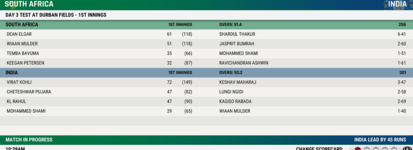
Ill be starting my second dig tomorrow on my day off, first task to wipe out their small lead then hopefully set them something tough...

Ill be starting my second dig tomorrow on my day off, first task to wipe out their small lead then hopefully set them something tough...
Nice one in brewing in Durban at the halfway stage with the SA sliders @Rumple43 , me as SA had the Indians in trouble at 190/7 but the late tail wag (as per) gave them a lead.
View attachment 260923
Ill be starting my second dig tomorrow on my day off, first task to wipe out their small lead then hopefully set them something tough...
Even though it’s perfectly playable.. I think this is where the re skilling is so useful at it wipes that tail end scripting of sorts and you get a far more authentic score
All being well, I should get a crack at the reskilled WI tail this afternoon, should hopefully still be an overcast spring day on a green pitch. Should be fodder, tbh.Even though it’s perfectly playable.. I think this is where the re skilling is so useful at it wipes that tail end scripting of sorts and you get a far more authentic score
I'll be annoyed if not, 9/10/11 have pretty much been reduced to 0's for batting ha
In short, I don't know. Purely because I've not had a chance to really test the changes yet.Rumple mate,
After the latest patch. Do we need to change the sliders. Or no? Since the pitch bounce has been apparently adjusted.
Or should we still follow the sliders as such.
I love these sliders. They are almost perfect.
I reckon, off the top of my head, that any medium pitch, so England and Asia (and potentially South Africa in future versions of the spreadsheet) will need the pitch bounce turning just a tiny bit. I get that people have reported "tennis ball bounce" on medium pitches, but I never really saw it and now I think the bounce is a bit too low as standard.
However, turning the bounce up should help the spinners, so might not actually be a bad thing.
If it does need a tweak, it won't be much. 3-5, tops perhaps. Probably want the top of the ball to just be at the bottom of the bails, maximum. This is a standard Jimmy delivery:
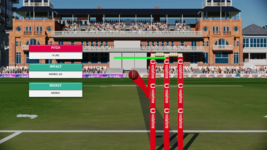
Probably want the top of the ball to be no higher than that green line. The danger is that Jimmy is probably England's lowest bounce bowler. If you raise it too high, someone like Broad, or Robinson, Archer, will all be too high, taking the stumps out of play again.
My advice, leave it where it is, or try 3-5 more and see how you get on.
Thanks mateeIn short, I don't know. Purely because I've not had a chance to really test the changes yet.
I reckon, off the top of my head, that any medium pitch, so England and Asia (and potentially South Africa in future versions of the spreadsheet) will need the pitch bounce turning just a tiny bit. I get that people have reported "tennis ball bounce" on medium pitches, but I never really saw it and now I think the bounce is a bit too low as standard.
However, turning the bounce up should help the spinners, so might not actually be a bad thing.
If it does need a tweak, it won't be much. 3-5, tops perhaps. Probably want the top of the ball to just be at the bottom of the bails, maximum. This is a standard Jimmy delivery:
View attachment 260969
Probably want the top of the ball to be no higher than that green line. The danger is that Jimmy is probably England's lowest bounce bowler. If you raise it too high, someone like Broad, or Robinson, Archer, will all be too high, taking the stumps out of play again.
My advice, leave it where it is, or try 3-5 more and see how you get on.
stanchez47
Little Timmy
- Joined
- Jul 21, 2011
- Online Cricket Games Owned
Hi all. Quick question -
So with the sliders being for particular pitch types does this mean when setting up a game the sliders need to match the pitch type being used or are the regional sliders (Asia/Australia/West Indies etc etc) a base and then you can use any type with it. For Example using the Australian sliders but picking a Grassy/Dusty wicket to mirror an old SCG or a Grassy wicket for Brisbane?
So with the sliders being for particular pitch types does this mean when setting up a game the sliders need to match the pitch type being used or are the regional sliders (Asia/Australia/West Indies etc etc) a base and then you can use any type with it. For Example using the Australian sliders but picking a Grassy/Dusty wicket to mirror an old SCG or a Grassy wicket for Brisbane?
The sliders have been made to match the pitch type, but that doesn't mean you have to match them. In fact, could be fun if you don't just to see how you get on.Hi all. Quick question -
So with the sliders being for particular pitch types does this mean when setting up a game the sliders need to match the pitch type being used or are the regional sliders (Asia/Australia/West Indies etc etc) a base and then you can use any type with it. For Example using the Australian sliders but picking a Grassy/Dusty wicket to mirror an old SCG or a Grassy wicket for Brisbane?
An example, from memory I think pace revs are low in England, lower than other places that seam less than English pitches would, but that setting is low for England in the slider sets because grassy, medium pitches tend to offer extra seam/cutter assistance anyway. Adding more movement via sliders then starts to get a bit extreme.
Right then, pitch wear.
I did ponder about posting this, since some of the physics have changed with the latest patch, but I figure the only thing BA have likely changed is bounce on medium pitches. That "shouldn't" affect wear, or anything else I found pre-patch.
As always, I'll whack stuff behind spoiler tags so that the post doesn't become too much of a beast.
For anyone that can't be bothered with my rambling posts (and I am aware there must be more than a few folk in that category), here's the long and short. If you want the reasoning behind the long and the short, you'll have to read on:
5 balls in the over, grab data, the usual deal etc. The sliders used were the same for all pitches, I didn't chop and change anything around, so any variance should have come from the pitch itself.
Eyes down, look in and here...we...go!
I did ponder about posting this, since some of the physics have changed with the latest patch, but I figure the only thing BA have likely changed is bounce on medium pitches. That "shouldn't" affect wear, or anything else I found pre-patch.
As always, I'll whack stuff behind spoiler tags so that the post doesn't become too much of a beast.
For anyone that can't be bothered with my rambling posts (and I am aware there must be more than a few folk in that category), here's the long and short. If you want the reasoning behind the long and the short, you'll have to read on:
- Pitch wear is apparent for seam bowlers
- These differences are shown by an increase in lateral movement, presumably off cracks that have developed on the pitch.
- These cracks do not appear to be immediately visible, but pitch wear is a visual thing. (These 3 points are covered in the first spoiler box)
- I can see less evidence of any pitch wear affecting spin bowling, but have other theories on this. (This is covered in the second spoiler box)
- I have a feeling that the weather (or another factor) may also affect pitch wear, but this has been harder to test. (This is covered in the third spoiler box)
5 balls in the over, grab data, the usual deal etc. The sliders used were the same for all pitches, I didn't chop and change anything around, so any variance should have come from the pitch itself.
Eyes down, look in and here...we...go!
I started by grabbing data in a number of related but different set ups. I have some grassy, some standard, and some dusty pitch data, and eight pitches in total were set up in slightly different ways.
Based on my bullet points above, I reckon that cracks form and affect lateral movement for seam bowlers.
Here are three different Day 1 overs from Jimmy, side by side. These are different types of pitch, but all are set to NONE for starting cracks:
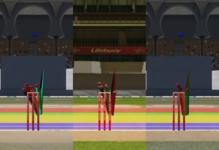
Pretty uniform. Nothing is misbehaving. This is as good as a pitch will get, and as such, there is very little unexpected lateral movement.
Now lets move on to compare the image above to something else. The following is from Day 1 of a HEAVY CRACKED, GRASSY pitch. Still day 1 like the three side-by-side images above, but we've opened those bad boys as much as we can from the get go:
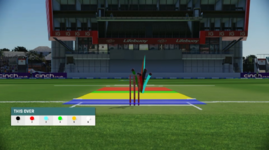
A much wider spread. Either Jimmy is off form and he's suddenly spraying it around, or we have some variance.
The pitch points appear fairly similar. Looking through the stumps there's nothing in the gap between off and middle, and the blue delivery, ball #3, appears the widest pitch mark just outside of off stump.
There's nothing that's leaping out as being way off, but the difference between the end point of green delivery to leg and the blue delivery to off is more than a set of stumps.
Remember, there's no differing user input here, it's the same every time with only the bowler's attributes to provide the differences ball to ball.
Let's take this a step further.
Below are two images from the same game, so the pitch is the same. The pitch is STANDARD, MEDIUM hardness, pitch that had NO CRACKS to begin with. Wear is set to FAST.
On the left is Day 1, on the right is Day 4:

No cracks on the left, Day 1. On the right is Day 4.
Again, looking at through the stumps, all balls on both sides of the image appear to be pitching on off stump or just wide of off stump. On the left, a lot of consistency. On the right, well, it's all over the place. There's two balls that pitched just outside off and have held their line, and three that have pitched maybe a few inches straighter on the stumps and two of them are then missing leg.
Here's a more dramatic one, to prove the point.
Here is a GRASSY, MEDIUM, HEAVILY CRACKED pitch, with FAST WEAR ON.
Here we're going to compare Day 1 and Day 4 again. Day 1 on the left, Day 4 on the right. The pitch is starting life fairly smashed up, let's see how it developed:

Well, that is fairly conclusive I reckon. Look at those two on the right that have pitched on off stump!! They're off to fine leg, the keeper can forget about them.
I also like the clump of three balls on the right of right hand image, the mega bad pitch. Heavy cracks that have then had 3 days of play on them. They all have fairly close pitch points, but the delivery that appears to have pitched the widest outside off stump actually crosses back over and would hit the top of off stump. I'd imagine if you left the green and dark red deliveries, you'd more than likely leave the brown one, and that'd take your timber out!
What is far less obvious, and a bit harder to document, is variable bounce. You can see from all the images above across the various different pitches and days, there's no alarming differences in bounce height. Some balls will have pitched slightly shorter or fuller than others, that's just Jimmy's natural variance. I certainly saw zero evidence of anything leaping up, or scooting low. All the movement was lateral.
Something else to note, and this is from a game that I did manage to get to Day 5, from memory it was a pristine track to start with, so this is 4 days of wear:
One delivery acting very differently, like a slower ball, or potentially the other four acting like a cross seamer. All were standard deliveries, but is this another variation that "cracks" help to produce? I noticed this effect more than once, most games in fact.
Based on my bullet points above, I reckon that cracks form and affect lateral movement for seam bowlers.
Here are three different Day 1 overs from Jimmy, side by side. These are different types of pitch, but all are set to NONE for starting cracks:

Pretty uniform. Nothing is misbehaving. This is as good as a pitch will get, and as such, there is very little unexpected lateral movement.
Now lets move on to compare the image above to something else. The following is from Day 1 of a HEAVY CRACKED, GRASSY pitch. Still day 1 like the three side-by-side images above, but we've opened those bad boys as much as we can from the get go:

A much wider spread. Either Jimmy is off form and he's suddenly spraying it around, or we have some variance.
The pitch points appear fairly similar. Looking through the stumps there's nothing in the gap between off and middle, and the blue delivery, ball #3, appears the widest pitch mark just outside of off stump.
There's nothing that's leaping out as being way off, but the difference between the end point of green delivery to leg and the blue delivery to off is more than a set of stumps.
Remember, there's no differing user input here, it's the same every time with only the bowler's attributes to provide the differences ball to ball.
Let's take this a step further.
Below are two images from the same game, so the pitch is the same. The pitch is STANDARD, MEDIUM hardness, pitch that had NO CRACKS to begin with. Wear is set to FAST.
On the left is Day 1, on the right is Day 4:

No cracks on the left, Day 1. On the right is Day 4.
Again, looking at through the stumps, all balls on both sides of the image appear to be pitching on off stump or just wide of off stump. On the left, a lot of consistency. On the right, well, it's all over the place. There's two balls that pitched just outside off and have held their line, and three that have pitched maybe a few inches straighter on the stumps and two of them are then missing leg.
Here's a more dramatic one, to prove the point.
Here is a GRASSY, MEDIUM, HEAVILY CRACKED pitch, with FAST WEAR ON.
Here we're going to compare Day 1 and Day 4 again. Day 1 on the left, Day 4 on the right. The pitch is starting life fairly smashed up, let's see how it developed:

Well, that is fairly conclusive I reckon. Look at those two on the right that have pitched on off stump!! They're off to fine leg, the keeper can forget about them.
I also like the clump of three balls on the right of right hand image, the mega bad pitch. Heavy cracks that have then had 3 days of play on them. They all have fairly close pitch points, but the delivery that appears to have pitched the widest outside off stump actually crosses back over and would hit the top of off stump. I'd imagine if you left the green and dark red deliveries, you'd more than likely leave the brown one, and that'd take your timber out!
What is far less obvious, and a bit harder to document, is variable bounce. You can see from all the images above across the various different pitches and days, there's no alarming differences in bounce height. Some balls will have pitched slightly shorter or fuller than others, that's just Jimmy's natural variance. I certainly saw zero evidence of anything leaping up, or scooting low. All the movement was lateral.
Something else to note, and this is from a game that I did manage to get to Day 5, from memory it was a pristine track to start with, so this is 4 days of wear:
One delivery acting very differently, like a slower ball, or potentially the other four acting like a cross seamer. All were standard deliveries, but is this another variation that "cracks" help to produce? I noticed this effect more than once, most games in fact.
So pitch wear is a thing. It creates lateral movement for seam bowlers, but as far as I can tell, there's no visual clue as to where the cracks are, or which balls will be affected.
So, that was easy. Pace bowling. Select a pitch, Day 1 data, Day 4 data, observe differences. Done! I suppose it was too much to ask for spin to be the same.
Let's do the same process as we did for pace above, and follow through.
Three Day 1 pitches, all with cracks set to NONE.
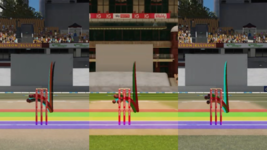
As an aside, it is pleasing the the only dusty track in there is the one on the left, which appears to show the most turn, so that's good. Either way, they all look pretty similar in terms of turn and bounce. As you'd expect on a spotless deck.
As before, now let's look at Day 1 of a HEAVILY CRACKED, GRASSY pitch:
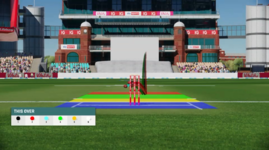
Not much doing there, I'll not lie. If anything, there is now less spin, with only a couple of deliveries missing leg stump and three now hitting middle and leg or leg.
Continuing the process below are two images from the same game, so the pitch is the same. The pitch is STANDARD, MEDIUM hardness, pitch that had NO CRACKS to begin with. Wear is set to FAST.
On the left is Day 1, on the right is Day 4:
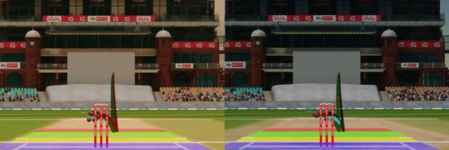
So pristine pitch on the left, and three days of play on the right. Looks to me that if anything, there's less spin on a worn pitch that a new one. And based on the image above, adding heavy cracks also appears to slightly reduce the amount of spin as well, compared to a pitch with no cracks. Odd.
Last one, completing the process.
Here is a GRASSY, MEDIUM, HEAVILY CRACKED pitch, with FAST WEAR ON.
Here we're going to compare Day 1 and Day 4 again. Day 1 on the left, Day 4 on the right:
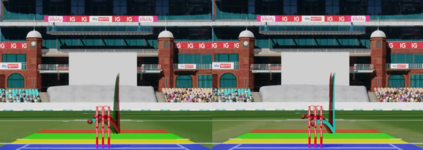
You could say the blue delivery on the right is the outlier here, that looks to have bounced and turned less. The grouping on Day 4 is perhaps a little wilder than on Day 1.
I can share all the data if people want, but in short, I'm seeing very little variation from a spin bowler regardless of pitch wear. Deliveries just all seem to clump together.
But, when simming games, and I did sim quite a few to get my data, the games pretty much all contained lower scores as games wore on, without fail almost. I saw some double digit 4th inning scores on the knackered, dusty pitches as well, with Ali taking five or more wickets for not many runs on more than one occasion.
For me, I think pitches do get more difficult to bat on, which leaves me to wonder why.
I have zero evidence to back this up, so take it as you will, but I think the game does something behind the scenes with spinners and spin sliders that make them harder for the AI to play as a game goes on. It could be the edge mechanics that increase, or something along those lines, but visually there is little to suggest there's any difference at all. Yet the game seems to play like there is. So.....IDK.
Let's do the same process as we did for pace above, and follow through.
Three Day 1 pitches, all with cracks set to NONE.

As an aside, it is pleasing the the only dusty track in there is the one on the left, which appears to show the most turn, so that's good. Either way, they all look pretty similar in terms of turn and bounce. As you'd expect on a spotless deck.
As before, now let's look at Day 1 of a HEAVILY CRACKED, GRASSY pitch:

Not much doing there, I'll not lie. If anything, there is now less spin, with only a couple of deliveries missing leg stump and three now hitting middle and leg or leg.
Continuing the process below are two images from the same game, so the pitch is the same. The pitch is STANDARD, MEDIUM hardness, pitch that had NO CRACKS to begin with. Wear is set to FAST.
On the left is Day 1, on the right is Day 4:

So pristine pitch on the left, and three days of play on the right. Looks to me that if anything, there's less spin on a worn pitch that a new one. And based on the image above, adding heavy cracks also appears to slightly reduce the amount of spin as well, compared to a pitch with no cracks. Odd.
Last one, completing the process.
Here is a GRASSY, MEDIUM, HEAVILY CRACKED pitch, with FAST WEAR ON.
Here we're going to compare Day 1 and Day 4 again. Day 1 on the left, Day 4 on the right:

You could say the blue delivery on the right is the outlier here, that looks to have bounced and turned less. The grouping on Day 4 is perhaps a little wilder than on Day 1.
I can share all the data if people want, but in short, I'm seeing very little variation from a spin bowler regardless of pitch wear. Deliveries just all seem to clump together.
But, when simming games, and I did sim quite a few to get my data, the games pretty much all contained lower scores as games wore on, without fail almost. I saw some double digit 4th inning scores on the knackered, dusty pitches as well, with Ali taking five or more wickets for not many runs on more than one occasion.
For me, I think pitches do get more difficult to bat on, which leaves me to wonder why.
I have zero evidence to back this up, so take it as you will, but I think the game does something behind the scenes with spinners and spin sliders that make them harder for the AI to play as a game goes on. It could be the edge mechanics that increase, or something along those lines, but visually there is little to suggest there's any difference at all. Yet the game seems to play like there is. So.....IDK.
So pitch wear is a thing for seamers, but it is a lot more murky for spinners. The data I saw suggested that spotless or heavily cracked pitches offered little difference, but there "could" be something going off behind the scenes.
Last one, you've done well to stay the course here, congrats!
Below is a four image grid. The pitch is identical in all images. It is a STANDARD pitch, MEDIUM hardness, NO CRACKS, FAST WEAR.
The top left image is Day 1 in England. The top right is Day 4 in England.
The bottom left is Day 1 in India. The bottom right is Day 4 in India.
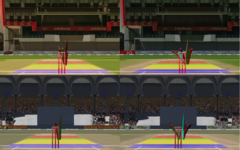
A few things....
Both left hand images (no cracks) continue the theme or little to no lateral movement. Good to see.
The bottom right image may be skewed by the two balls that have pitched between middle and off. These must have just been bad ones from Jimmy, sadly.
Can we say the bottom right image has the most lateral movement? The forecast in the bottom Indian images was 30-35c throughout. The top images in England were set to Autumn, with a max of 10c. Can we say that the heat has done anything different to the two images on the right by Day 4? I'm unsure.
Let's try again. Same deal.
Below is a four image grid. The pitch is identical in all images. It is a DUSTY pitch, MEDIUM hardness, HEAVY CRACKS, FAST WEAR.
The top left image is Day 1 in England. The top right is Day 4 in England. Less than 10c throughout.
The bottom left is Day 1 in India. The bottom right is Day 4 in India. North of 30c throughout.
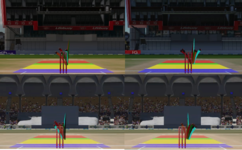
Do we think the top right, England Day 4, has the most movement? The pitches are identical remember. We're only talking about the temperature here.
Could it be a bit like spin, and the reverse of what we think is actually a thing. You bring the temperatures down and cracks get a bit wider? I don't know. I want to say that weather causes some form of difference though. Maybe it just needs more testing.
Below is a four image grid. The pitch is identical in all images. It is a STANDARD pitch, MEDIUM hardness, NO CRACKS, FAST WEAR.
The top left image is Day 1 in England. The top right is Day 4 in England.
The bottom left is Day 1 in India. The bottom right is Day 4 in India.

A few things....
Both left hand images (no cracks) continue the theme or little to no lateral movement. Good to see.
The bottom right image may be skewed by the two balls that have pitched between middle and off. These must have just been bad ones from Jimmy, sadly.
Can we say the bottom right image has the most lateral movement? The forecast in the bottom Indian images was 30-35c throughout. The top images in England were set to Autumn, with a max of 10c. Can we say that the heat has done anything different to the two images on the right by Day 4? I'm unsure.
Let's try again. Same deal.
Below is a four image grid. The pitch is identical in all images. It is a DUSTY pitch, MEDIUM hardness, HEAVY CRACKS, FAST WEAR.
The top left image is Day 1 in England. The top right is Day 4 in England. Less than 10c throughout.
The bottom left is Day 1 in India. The bottom right is Day 4 in India. North of 30c throughout.

Do we think the top right, England Day 4, has the most movement? The pitches are identical remember. We're only talking about the temperature here.
Could it be a bit like spin, and the reverse of what we think is actually a thing. You bring the temperatures down and cracks get a bit wider? I don't know. I want to say that weather causes some form of difference though. Maybe it just needs more testing.
tarrantino
Associate Captain
Excellent insight and presented really well.Right then, pitch wear.
I did ponder about posting this, since some of the physics have changed with the latest patch, but I figure the only thing BA have likely changed is bounce on medium pitches. That "shouldn't" affect wear, or anything else I found pre-patch.
As always, I'll whack stuff behind spoiler tags so that the post doesn't become too much of a beast.
For anyone that can't be bothered with my rambling posts (and I am aware there must be more than a few folk in that category), here's the long and short. If you want the reasoning behind the long and the short, you'll have to read on:
For reference, Jimmy Anderson and Moeen Ali were used as the seamer and spinner in all instances. I played England v England with identical line ups. All English games were played at Old Trafford. All Indian games were played at Delhi. All deliveries are standard, standard speed, and there's no after touch input provided at all.
- Pitch wear is apparent for seam bowlers
- These differences are shown by an increase in lateral movement, presumably off cracks that have developed on the pitch.
- These cracks do not appear to be immediately visible, but pitch wear is a visual thing. (These 3 points are covered in the first spoiler box)
- I can see less evidence of any pitch wear affecting spin bowling, but have other theories on this. (This is covered in the second spoiler box)
- I have a feeling that the weather (or another factor) may also affect pitch wear, but this has been harder to test. (This is covered in the third spoiler box)
5 balls in the over, grab data, the usual deal etc. The sliders used were the same for all pitches, I didn't chop and change anything around, so any variance should have come from the pitch itself.
Eyes down, look in and here...we...go!
I started by grabbing data in a number of related but different set ups. I have some grassy, some standard, and some dusty pitch data, and eight pitches in total were set up in slightly different ways.
Based on my bullet points above, I reckon that cracks form and affect lateral movement for seam bowlers.
Here are three different Day 1 overs from Jimmy, side by side. These are different types of pitch, but all are set to NONE for starting cracks:
View attachment 261043
Pretty uniform. Nothing is misbehaving. This is as good as a pitch will get, and as such, there is very little unexpected lateral movement.
Now lets move on to compare the image above to something else. The following is from Day 1 of a HEAVY CRACKED, GRASSY pitch. Still day 1 like the three side-by-side images above, but we've opened those bad boys as much as we can from the get go:
View attachment 261044
A much wider spread. Either Jimmy is off form and he's suddenly spraying it around, or we have some variance.
The pitch points appear fairly similar. Looking through the stumps there's nothing in the gap between off and middle, and the blue delivery, ball #3, appears the widest pitch mark just outside of off stump.
There's nothing that's leaping out as being way off, but the difference between the end point of green delivery to leg and the blue delivery to off is more than a set of stumps.
Remember, there's no differing user input here, it's the same every time with only the bowler's attributes to provide the differences ball to ball.
Let's take this a step further.
Below are two images from the same game, so the pitch is the same. The pitch is STANDARD, MEDIUM hardness, pitch that had NO CRACKS to begin with. Wear is set to FAST.
On the left is Day 1, on the right is Day 4:
View attachment 261046
No cracks on the left, Day 1. On the right is Day 4.
Again, looking at through the stumps, all balls on both sides of the image appear to be pitching on off stump or just wide of off stump. On the left, a lot of consistency. On the right, well, it's all over the place. There's two balls that pitched just outside off and have held their line, and three that have pitched maybe a few inches straighter on the stumps and two of them are then missing leg.
Here's a more dramatic one, to prove the point.
Here is a GRASSY, MEDIUM, HEAVILY CRACKED pitch, with FAST WEAR ON.
Here we're going to compare Day 1 and Day 4 again. Day 1 on the left, Day 4 on the right. The pitch is starting life fairly smashed up, let's see how it developed:
View attachment 261048
Well, that is fairly conclusive I reckon. Look at those two on the right that have pitched on off stump!! They're off to fine leg, the keeper can forget about them.
I also like the clump of three balls on the right of right hand image, the mega bad pitch. Heavy cracks that have then had 3 days of play on them. They all have fairly close pitch points, but the delivery that appears to have pitched the widest outside off stump actually crosses back over and would hit the top of off stump. I'd imagine if you left the green and dark red deliveries, you'd more than likely leave the brown one, and that'd take your timber out!
What is far less obvious, and a bit harder to document, is variable bounce. You can see from all the images above across the various different pitches and days, there's no alarming differences in bounce height. Some balls will have pitched slightly shorter or fuller than others, that's just Jimmy's natural variance. I certainly saw zero evidence of anything leaping up, or scooting low. All the movement was lateral.
Something else to note, and this is from a game that I did manage to get to Day 5, from memory it was a pristine track to start with, so this is 4 days of wear:
One delivery acting very differently, like a slower ball, or potentially the other four acting like a cross seamer. All were standard deliveries, but is this another variation that "cracks" help to produce? I noticed this effect more than once, most games in fact.
So pitch wear is a thing. It creates lateral movement for seam bowlers, but as far as I can tell, there's no visual clue as to where the cracks are, or which balls will be affected.
So, that was easy. Pace bowling. Select a pitch, Day 1 data, Day 4 data, observe differences. Done! I suppose it was too much to ask for spin to be the same.
Let's do the same process as we did for pace above, and follow through.
Three Day 1 pitches, all with cracks set to NONE.
View attachment 261049
As an aside, it is pleasing the the only dusty track in there is the one on the left, which appears to show the most turn, so that's good. Either way, they all look pretty similar in terms of turn and bounce. As you'd expect on a spotless deck.
As before, now let's look at Day 1 of a HEAVILY CRACKED, GRASSY pitch:
View attachment 261050
Not much doing there, I'll not lie. If anything, there is now less spin, with only a couple of deliveries missing leg stump and three now hitting middle and leg or leg.
Continuing the process below are two images from the same game, so the pitch is the same. The pitch is STANDARD, MEDIUM hardness, pitch that had NO CRACKS to begin with. Wear is set to FAST.
On the left is Day 1, on the right is Day 4:
View attachment 261051
So pristine pitch on the left, and three days of play on the right. Looks to me that if anything, there's less spin on a worn pitch that a new one. And based on the image above, adding heavy cracks also appears to slightly reduce the amount of spin as well, compared to a pitch with no cracks. Odd.
Last one, completing the process.
Here is a GRASSY, MEDIUM, HEAVILY CRACKED pitch, with FAST WEAR ON.
Here we're going to compare Day 1 and Day 4 again. Day 1 on the left, Day 4 on the right:
View attachment 261052
You could say the blue delivery on the right is the outlier here, that looks to have bounced and turned less. The grouping on Day 4 is perhaps a little wilder than on Day 1.
I can share all the data if people want, but in short, I'm seeing very little variation from a spin bowler regardless of pitch wear. Deliveries just all seem to clump together.
But, when simming games, and I did sim quite a few to get my data, the games pretty much all contained lower scores as games wore on, without fail almost. I saw some double digit 4th inning scores on the knackered, dusty pitches as well, with Ali taking five or more wickets for not many runs on more than one occasion.
For me, I think pitches do get more difficult to bat on, which leaves me to wonder why.
I have zero evidence to back this up, so take it as you will, but I think the game does something behind the scenes with spinners and spin sliders that make them harder for the AI to play as a game goes on. It could be the edge mechanics that increase, or something along those lines, but visually there is little to suggest there's any difference at all. Yet the game seems to play like there is. So.....IDK.
So pitch wear is a thing for seamers, but it is a lot more murky for spinners. The data I saw suggested that spotless or heavily cracked pitches offered little difference, but there "could" be something going off behind the scenes.
Last one, you've done well to stay the course here, congrats!
Below is a four image grid. The pitch is identical in all images. It is a STANDARD pitch, MEDIUM hardness, NO CRACKS, FAST WEAR.
The top left image is Day 1 in England. The top right is Day 4 in England.
The bottom left is Day 1 in India. The bottom right is Day 4 in India.
View attachment 261054
A few things....
Both left hand images (no cracks) continue the theme or little to no lateral movement. Good to see.
The bottom right image may be skewed by the two balls that have pitched between middle and off. These must have just been bad ones from Jimmy, sadly.
Can we say the bottom right image has the most lateral movement? The forecast in the bottom Indian images was 30-35c throughout. The top images in England were set to Autumn, with a max of 10c. Can we say that the heat has done anything different to the two images on the right by Day 4? I'm unsure.
Let's try again. Same deal.
Below is a four image grid. The pitch is identical in all images. It is a DUSTY pitch, MEDIUM hardness, HEAVY CRACKS, FAST WEAR.
The top left image is Day 1 in England. The top right is Day 4 in England. Less than 10c throughout.
The bottom left is Day 1 in India. The bottom right is Day 4 in India. North of 30c throughout.
View attachment 261055
Do we think the top right, England Day 4, has the most movement? The pitches are identical remember. We're only talking about the temperature here.
Could it be a bit like spin, and the reverse of what we think is actually a thing. You bring the temperatures down and cracks get a bit wider? I don't know. I want to say that weather causes some form of difference though. Maybe it just needs more testing.
Right then, pitch wear.
I did ponder about posting this, since some of the physics have changed with the latest patch, but I figure the only thing BA have likely changed is bounce on medium pitches. That "shouldn't" affect wear, or anything else I found pre-patch.
As always, I'll whack stuff behind spoiler tags so that the post doesn't become too much of a beast.
For anyone that can't be bothered with my rambling posts (and I am aware there must be more than a few folk in that category), here's the long and short. If you want the reasoning behind the long and the short, you'll have to read on:
For reference, Jimmy Anderson and Moeen Ali were used as the seamer and spinner in all instances. I played England v England with identical line ups. All English games were played at Old Trafford. All Indian games were played at Delhi. All deliveries are standard, standard speed, and there's no after touch input provided at all.
- Pitch wear is apparent for seam bowlers
- These differences are shown by an increase in lateral movement, presumably off cracks that have developed on the pitch.
- These cracks do not appear to be immediately visible, but pitch wear is a visual thing. (These 3 points are covered in the first spoiler box)
- I can see less evidence of any pitch wear affecting spin bowling, but have other theories on this. (This is covered in the second spoiler box)
- I have a feeling that the weather (or another factor) may also affect pitch wear, but this has been harder to test. (This is covered in the third spoiler box)
5 balls in the over, grab data, the usual deal etc. The sliders used were the same for all pitches, I didn't chop and change anything around, so any variance should have come from the pitch itself.
Eyes down, look in and here...we...go!
I started by grabbing data in a number of related but different set ups. I have some grassy, some standard, and some dusty pitch data, and eight pitches in total were set up in slightly different ways.
Based on my bullet points above, I reckon that cracks form and affect lateral movement for seam bowlers.
Here are three different Day 1 overs from Jimmy, side by side. These are different types of pitch, but all are set to NONE for starting cracks:
View attachment 261043
Pretty uniform. Nothing is misbehaving. This is as good as a pitch will get, and as such, there is very little unexpected lateral movement.
Now lets move on to compare the image above to something else. The following is from Day 1 of a HEAVY CRACKED, GRASSY pitch. Still day 1 like the three side-by-side images above, but we've opened those bad boys as much as we can from the get go:
View attachment 261044
A much wider spread. Either Jimmy is off form and he's suddenly spraying it around, or we have some variance.
The pitch points appear fairly similar. Looking through the stumps there's nothing in the gap between off and middle, and the blue delivery, ball #3, appears the widest pitch mark just outside of off stump.
There's nothing that's leaping out as being way off, but the difference between the end point of green delivery to leg and the blue delivery to off is more than a set of stumps.
Remember, there's no differing user input here, it's the same every time with only the bowler's attributes to provide the differences ball to ball.
Let's take this a step further.
Below are two images from the same game, so the pitch is the same. The pitch is STANDARD, MEDIUM hardness, pitch that had NO CRACKS to begin with. Wear is set to FAST.
On the left is Day 1, on the right is Day 4:
View attachment 261046
No cracks on the left, Day 1. On the right is Day 4.
Again, looking at through the stumps, all balls on both sides of the image appear to be pitching on off stump or just wide of off stump. On the left, a lot of consistency. On the right, well, it's all over the place. There's two balls that pitched just outside off and have held their line, and three that have pitched maybe a few inches straighter on the stumps and two of them are then missing leg.
Here's a more dramatic one, to prove the point.
Here is a GRASSY, MEDIUM, HEAVILY CRACKED pitch, with FAST WEAR ON.
Here we're going to compare Day 1 and Day 4 again. Day 1 on the left, Day 4 on the right. The pitch is starting life fairly smashed up, let's see how it developed:
View attachment 261048
Well, that is fairly conclusive I reckon. Look at those two on the right that have pitched on off stump!! They're off to fine leg, the keeper can forget about them.
I also like the clump of three balls on the right of right hand image, the mega bad pitch. Heavy cracks that have then had 3 days of play on them. They all have fairly close pitch points, but the delivery that appears to have pitched the widest outside off stump actually crosses back over and would hit the top of off stump. I'd imagine if you left the green and dark red deliveries, you'd more than likely leave the brown one, and that'd take your timber out!
What is far less obvious, and a bit harder to document, is variable bounce. You can see from all the images above across the various different pitches and days, there's no alarming differences in bounce height. Some balls will have pitched slightly shorter or fuller than others, that's just Jimmy's natural variance. I certainly saw zero evidence of anything leaping up, or scooting low. All the movement was lateral.
Something else to note, and this is from a game that I did manage to get to Day 5, from memory it was a pristine track to start with, so this is 4 days of wear:
One delivery acting very differently, like a slower ball, or potentially the other four acting like a cross seamer. All were standard deliveries, but is this another variation that "cracks" help to produce? I noticed this effect more than once, most games in fact.
So pitch wear is a thing. It creates lateral movement for seam bowlers, but as far as I can tell, there's no visual clue as to where the cracks are, or which balls will be affected.
So, that was easy. Pace bowling. Select a pitch, Day 1 data, Day 4 data, observe differences. Done! I suppose it was too much to ask for spin to be the same.
Let's do the same process as we did for pace above, and follow through.
Three Day 1 pitches, all with cracks set to NONE.
View attachment 261049
As an aside, it is pleasing the the only dusty track in there is the one on the left, which appears to show the most turn, so that's good. Either way, they all look pretty similar in terms of turn and bounce. As you'd expect on a spotless deck.
As before, now let's look at Day 1 of a HEAVILY CRACKED, GRASSY pitch:
View attachment 261050
Not much doing there, I'll not lie. If anything, there is now less spin, with only a couple of deliveries missing leg stump and three now hitting middle and leg or leg.
Continuing the process below are two images from the same game, so the pitch is the same. The pitch is STANDARD, MEDIUM hardness, pitch that had NO CRACKS to begin with. Wear is set to FAST.
On the left is Day 1, on the right is Day 4:
View attachment 261051
So pristine pitch on the left, and three days of play on the right. Looks to me that if anything, there's less spin on a worn pitch that a new one. And based on the image above, adding heavy cracks also appears to slightly reduce the amount of spin as well, compared to a pitch with no cracks. Odd.
Last one, completing the process.
Here is a GRASSY, MEDIUM, HEAVILY CRACKED pitch, with FAST WEAR ON.
Here we're going to compare Day 1 and Day 4 again. Day 1 on the left, Day 4 on the right:
View attachment 261052
You could say the blue delivery on the right is the outlier here, that looks to have bounced and turned less. The grouping on Day 4 is perhaps a little wilder than on Day 1.
I can share all the data if people want, but in short, I'm seeing very little variation from a spin bowler regardless of pitch wear. Deliveries just all seem to clump together.
But, when simming games, and I did sim quite a few to get my data, the games pretty much all contained lower scores as games wore on, without fail almost. I saw some double digit 4th inning scores on the knackered, dusty pitches as well, with Ali taking five or more wickets for not many runs on more than one occasion.
For me, I think pitches do get more difficult to bat on, which leaves me to wonder why.
I have zero evidence to back this up, so take it as you will, but I think the game does something behind the scenes with spinners and spin sliders that make them harder for the AI to play as a game goes on. It could be the edge mechanics that increase, or something along those lines, but visually there is little to suggest there's any difference at all. Yet the game seems to play like there is. So.....IDK.
So pitch wear is a thing for seamers, but it is a lot more murky for spinners. The data I saw suggested that spotless or heavily cracked pitches offered little difference, but there "could" be something going off behind the scenes.
Last one, you've done well to stay the course here, congrats!
Below is a four image grid. The pitch is identical in all images. It is a STANDARD pitch, MEDIUM hardness, NO CRACKS, FAST WEAR.
The top left image is Day 1 in England. The top right is Day 4 in England.
The bottom left is Day 1 in India. The bottom right is Day 4 in India.
View attachment 261054
A few things....
Both left hand images (no cracks) continue the theme or little to no lateral movement. Good to see.
The bottom right image may be skewed by the two balls that have pitched between middle and off. These must have just been bad ones from Jimmy, sadly.
Can we say the bottom right image has the most lateral movement? The forecast in the bottom Indian images was 30-35c throughout. The top images in England were set to Autumn, with a max of 10c. Can we say that the heat has done anything different to the two images on the right by Day 4? I'm unsure.
Let's try again. Same deal.
Below is a four image grid. The pitch is identical in all images. It is a DUSTY pitch, MEDIUM hardness, HEAVY CRACKS, FAST WEAR.
The top left image is Day 1 in England. The top right is Day 4 in England. Less than 10c throughout.
The bottom left is Day 1 in India. The bottom right is Day 4 in India. North of 30c throughout.
View attachment 261055
Do we think the top right, England Day 4, has the most movement? The pitches are identical remember. We're only talking about the temperature here.
Could it be a bit like spin, and the reverse of what we think is actually a thing. You bring the temperatures down and cracks get a bit wider? I don't know. I want to say that weather causes some form of difference though. Maybe it just needs more testing.
Thanks for all of that. Great analysis and insight and makes me really feel that BA have put some variation into the game.
My only issue with it is that no matter where the ball pitches, turns, bounces etc the AI batsmen always know whether it's hitting the stumps or not so automatically leave everything. So in theory it should become harder to bat on as the pitch wears, as in real life but on the game the AI seems to have already decided seemingly before the ball has been bowled whether its a leave, a scoring shot or a wicket unfortunately.
Similar threads
- Replies
- 4
- Views
- 3K
- Replies
- 81
- Views
- 34K
- Replies
- 109
- Views
- 38K
Users who are viewing this thread
Total: 1 (members: 0, guests: 1)



